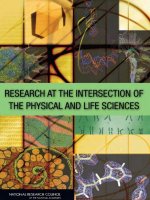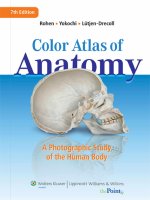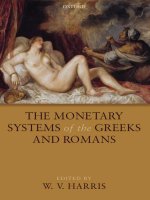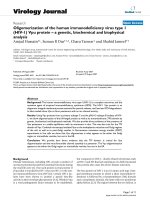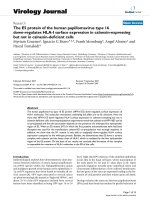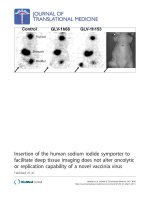5 4 systems of the human body (life sciences)
Bạn đang xem bản rút gọn của tài liệu. Xem và tải ngay bản đầy đủ của tài liệu tại đây (5.97 MB, 10 trang )
Life Sciences
Standards
Preview
Standard Set 2. Life Sciences
2. Plants and animals have structures for
respiration, digestion, waste disposal,
and transport of materials. As a basis
for understanding this concept:
2.a. Students know many multicellular
organisms have specialized structures
to support the transport of materials.
2.b. Students know how blood
circulates through the heart chambers,
lungs, and body and how carbon
dioxide (CO2) and oxygen (O2) are
exchanged in the lungs and tissues.
Genre
Nonfiction
Comprehension Skill
Sequence
2.c. Students know the sequential
steps of digestion and the roles of
teeth and the mouth, esophagus,
stomach, small intestine, large
intestine, and colon in the function of
the digestive system.
2.d. Students know the role of the
kidney in removing cellular waste from
blood and converting it into urine,
which is stored in the bladder.
Text Features
• Captions
• Diagrams
• Glossary
Science Content
Human Body
Scott Foresman Science 5.4
ISBN 0-328-23462-1
ì<(sk$m)=cdegc < +^-Ä-U-Ä-U
by Ann Cambal
Vocabulary
air sacs
artery
bladder
bronchiole
capillary
digestion
esophagus
large intestine
small intestine
trachea
vein
Picture Credits
Every effort has been made to secure permission and provide appropriate credit for photographic material.
The publisher deeply regrets any omission and pledges to correct errors called to its attention in subsequent editions.
Unless otherwise acknowledged, all photographs are the copyright © of Dorling Kindersley, a division of Pearson.
ISBN: 0-328-23462-1
Copyright © Pearson Education, Inc. All Rights Reserved. Printed in the United States of America.
This publication is protected by Copyright, and permission should be obtained from the publisher prior to any
prohibited reproduction, storage in a retrieval system, or transmission in any form by any means, electronic,
mechanical, photocopying, recording, or likewise. For information regarding permission(s), write to
Permissions Department, Scott Foresman, 1900 East Lake Avenue, Glenview, Illinois 60025.
1 2 3 4 5 6 7 8 9 10 V010 13 12 11 10 09 08 07 06
by Ann Cambal
Everyone Needs
Healthy Systems
There are several systems that make up the human body.
Although their functions differ, they all work together to keep
your body “running” smoothly. Some of these systems include
the circulatory, respiratory, digestive, and urinary systems.
Blood Vessels
The circulatory system of the human body consists of the
heart, the blood, and the tubes known as blood vessels. This system
constantly works to supply your body with oxygen and nutrients.
There are three kinds of blood vessels that transport blood
throughout your body. They are arteries, capillaries, and veins.
Arteries are blood vessels that carry blood away from the
heart to other parts of the body. It’s their job to carry blood
that is rich in oxygen and deliver it to all parts of your body.
The walls of arteries are thick and muscular. They can stretch
out as the heart pushes blood through them. The smallest
arteries branch out into capillaries. A capillary is the smallest
kind of blood vessel. The oxygen in your blood moves from the
capillaries into your cells. The wastes and carbon dioxide move
out of the cells and back into the capillaries. Unlike arteries,
capillary walls are very thin. In fact, they are only one cell thick.
Gases can pass through these thin walls.
Capillaries join together to make small veins. These small
veins join together to make larger veins. Veins are blood vessels
that transport blood toward the heart. They help the return
trip of blood to the heart. They have valves that are like doors.
These valves make sure the blood only flows in
one direction. They open to let blood flow to
the heart and close if blood begins to flow away
from the heart.
Artery
Capillary
Vein
The human body contains
a great number of blood
vessels. These blood vessels
form a huge and complex
network within all parts of
the body.
2
3
The Human Heart
The heart is a vital muscle. In an
adult human, it is about the size of a
fist. The heart beats twenty-four hours
a day—when you’re awake and when
you’re asleep—in order to pump blood to
all parts of the body.
There are four chambers in the
human heart. These chambers are made
of a special kind of muscle. They work
together in a rhythm that’s based on
how active you are being at the time.
Two chambers make up each side of
the heart. The right atrium and right
ventricle make up one side, and the left
atrium and left ventricle make up the
other side. The atrium is the upper part
and the ventricle is the lower part. The
ventricle is stronger than the atrium.
The left and right sides of the heart
work separately to pump blood on
different paths. The heart contracts in
order to pump blood.
The hearts of animals and humans
are not the same. Many reptiles have
three chambers that make up their
heart. Fish only have two chambers.
4
Vein
Aorta
Left Atrium Blood
flows from the lungs into
the left atrium. The left
atrium squeezes blood
into the left ventricle.
Valve
The Right Atrium
relaxes and fills with
blood. This blood
carries wastes and
carbon dioxide from
body cells. Then the
right atrium squeezes
the blood into the
right ventricle.
The Left Ventricle
pumps oxygen-rich
blood away from the
heart. It goes to the
aorta. The aorta is the
body’s largest artery.
The blood moves to
smaller arteries that
carry it to the cells.
The Right Ventricle
pumps blood into an
artery that goes to
the lungs. There it
can exchange carbon
dioxide for oxygen.
5
The Job of the
Respiratory System
Sinus
The respiratory system moves oxygen and carbon dioxide
between the air and your blood.
Respiratory Parts
You inhale, or breathe air in, through your mouth and nose.
This is how respiration starts. Your sinuses work to warm and
moisten the air you breathe. Inside your nose are small hairs and a
layer of mucus. These work to trap dirt and germs from getting into
your lungs. From the nose, the air moves to the back of the throat
and into the larynx. This is where the vocal cords are.
The trachea is a tube that carries the air from the
larynx toward the lungs. It branches into two tubes a
little below where your neck joins your body. These two
smaller tubes are the left and right bronchi. They deliver
air into your left and right lungs. Inside the lungs, the
bronchi branch out into smaller and smaller tubes.
These are called bronchioles.
The bronchioles finally end in tiny air sacs in the
lungs. The air sacs are where oxygen enters the blood
and carbon dioxide leaves it. At the bottom of your
chest is the diaphragm. This dome-shaped muscle
expands and contracts. When it expands, it forces air
out of your lungs and you exhale. When it contracts,
you inhale, or breathe air in.
Larynx
Cilia are tiny hairlike
structures on cells. Many
parts of the respiratory
system have cilia. Cilia help
clean the air you breathe
by waving very fast.
Trachea
Lung
Bronchioles
Bronchi
Diaphragm
6
7
Systems Work Together
Living things require oxygen. Oxygen is important because it
helps cells release the energy that they need from sugar. Insects
have a respiratory system. They breathe in oxygen through
openings on their sides. Worms have a circulatory system. This
helps them get oxygen. Their blood absorbs oxygen that is
carried through their body.
Humans are more complex living things. Their respiratory
and circulatory systems work together to get oxygen to cells.
It all begins when you take a breath. Breathing—inhaling and
exhaling—is the job of the respiratory system. Oxygen comes in
from the air that you breathe. Oxygen fills the lungs. The lungs
make oxygen available to the circulatory system so that it can
be transported by your blood. Carbon dioxide is removed from
your blood and exhaled back out to the air outside your body.
Two things are happening at the same time in the air sacs.
Oxygen leaves the lungs and enters the blood. Carbon dioxide
leaves the blood and enters the lungs. If you hold your breath,
carbon dioxide builds up in your blood. The muscles in your
diaphragm contract, forcing you to breathe. This is one way
your systems work together to supply you with oxygen.
Air sacs have very
thin walls.
The arteries that go
from the heart to the
lungs branch into
smaller and smaller
blood vessels. The
tiniest blood vessels
are the capillaries.
Notice the web of
capillaries around each
air sac.
Oxygen passes from the air sacs into
the blood of the capillaries. At the
same time, carbon dioxide goes from
the blood into the air sacs. The two
gases switch places. Then the air
moves out of the lungs.
8
9
The Digestive and
Urinary Systems
Digestive System
Turning the food you eat into fuel that your body can use
is the job of the digestive system. Digestion is the process that
changes food into forms that the body can use. Many organs
work together to break down food into very small bits of
materials. Once the food is broken down it can be carried by the
blood to your cells.
The teeth are not just hard
structures. They contain living
cells, blood vessels, and nerves.
Front teeth have a thin shape
to help you cut food when you
bite into it. Flatter teeth in the
back of the mouth grind and
crush food as you chew.
The epiglottis covers your
trachea when you swallow. It
keeps food from “going down
the wrong pipe.” It makes
food go down the esophagus
instead of into the lungs.
The Mouth and Esophagus
Where does the digestive system
begin? With the mouth, of course! In the
mouth you chew pieces of food so that
they become small enough to swallow. The
taste buds on your tongue bring out the
flavors of the food. The tongue also helps
move food to the back of your mouth.
From there the food passes into a tube
called the esophagus. This organ is made
up of rings of muscle. The muscles move in
a pattern to squeeze the food as it travels
down the tube to the stomach. Muscles
behind the food get tight as the food passes
through each ring. This entire process
doesn’t take very long. Food reaches the
stomach in about two or three seconds.
10
The salivary glands
make saliva. Saliva has
chemicals that digest
food.
Tongue The tongue
moves food around
your mouth so you
can chew it better. It
also moves food to
the back of the mouth
so you can swallow
it. Tiny taste buds on
your tongue have
special nerves in them.
They help you taste
the foods you eat.
Trachea
Esophagus The surface of
the esophagus has many
tiny ridges.
11
The Stomach and Intestines
Where is your stomach? It’s on the left side of your
body under your ribs. The walls of your stomach are
muscles. They can stretch enough to hold all the food
you eat in a meal. When you swallow, a muscle at the
bottom of your esophagus opens up. This allows food
to reach your stomach. The muscle then closes to keep
food there. The stomach muscles squeeze together at
the same time the stomach releases acids to break down
food. This soupy mixture is then ready for the next step
in digestion.
The partly digested food leaves the stomach and
enters the small intestine. This is a narrow, winding
tube. Over several hours, the small intestine breaks
down food even further. This is done with the help
of the liver and the pancreas. These organs send
chemicals to aid in digestion.
When the process of digestion is finished, the
digested food particles move into the blood vessels
in the small intestine. Some food, however, cannot
be digested in the small intestine. This undigested
food moves to the large intestine, often called
the colon. Here some water is recovered from the
food. The waste will be stored in another part of the
colon, until it is removed from the body.
Esophagus
Stomach
Stomach Walls The
walls of the stomach
ooze mucus to keep the
stomach from digesting
itself.
Large
intestine
Small
intestine
12
13
The Urinary System
Wastes from your body cells enter your blood. If they
stayed there for a long time, they would poison you.
Therefore, this waste must be removed. In humans,
waste is removed from the blood mostly by the
urinary system.
Humans have a pair of organs called the
kidneys. Kidneys have the same dark red
color and shape as kidney beans. Located
below the lowest ribs, there is one kidney
on either side of your backbone.
Kidneys filter wastes out of the blood.
This mix of water and wastes is called
urine. There’s a tube from each kidney
that carries urine to the urinary bladder.
The bladder is a sac that collects and
stores urine. At the bottom of the
bladder is a tight muscle. This holds
the urine in the bladder until the body
removes it through urination.
As the kidneys filter waste, other
materials leave the blood too. These
materials include salt, calcium, and
other nutrients your body needs. The
kidneys put the right amount of these
materials back into your blood. They help
to maintain a balance. Other organs besides
kidneys remove wastes. When you sweat, your
glands release a little bit of waste too.
14
The Kidney
Blood filters
This artery
transports blood
to the kidney to
be cleaned.
This vein
transports
cleaned blood
out of the kidney
and back to the
heart.
The tubes
carrying wastes
come together to
make larger and
larger tubes.
This tube carries
urine from the
kidney to the
bladder.
15
Glossary
air sacs
artery
bladder
the thin-walled sacs in the lungs where
oxygen enters the blood and carbon dioxide
leaves the blood
1. What is the purpose of the circulatory system?
2. What system provides the oxygen that’s carried in your blood?
3. Where are the kidneys, and what do they do?
a blood vessel that carries blood away from
the heart to other parts of the body
4.
the sac that collects and stores urine formed
by the kidneys
Write one page about the role muscles play
in the different systems of your body and why this is important.
5.
Sequence Describe the sequence in which air flows through
your respiratory system, from when you first inhale to the moment
it enters your lungs.
bronchiole
a small tube in the lungs that carries air to
air sacs
capillary
the smallest kind of blood vessels
digestion
the process that changes food into a form
that the body can use
esophagus
the tube that carries food from the mouth to
the stomach
large intestine
a wider tube connected to the small intestine
that removes water from undigested food
and stores this waste until it is removed from
the body
small intestine
a narrow, winding tube where food is
changed chemically and broken down into
small particles that can be absorbed into
the blood
trachea
the tube that carries air from the larynx to
the lungs
vein
a blood vessel that carries blood toward
the heart
16
What did you learn?



